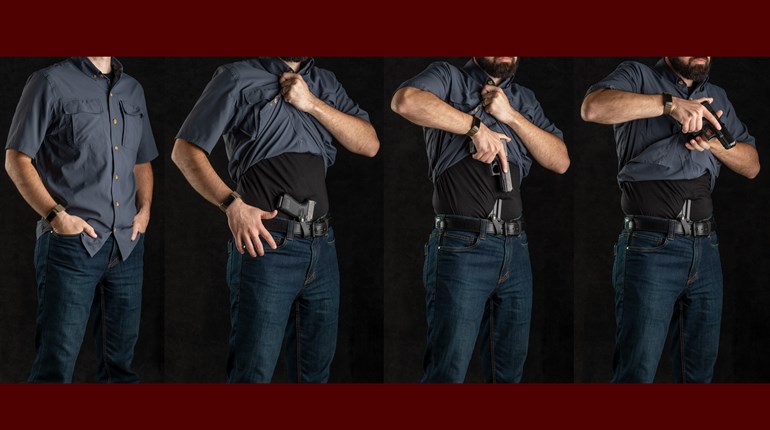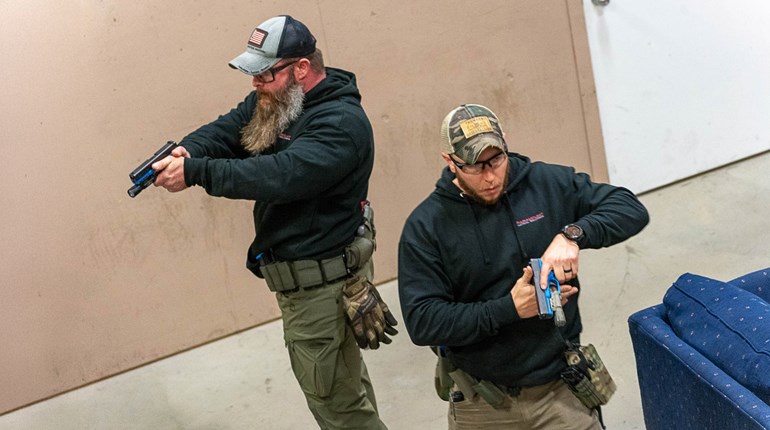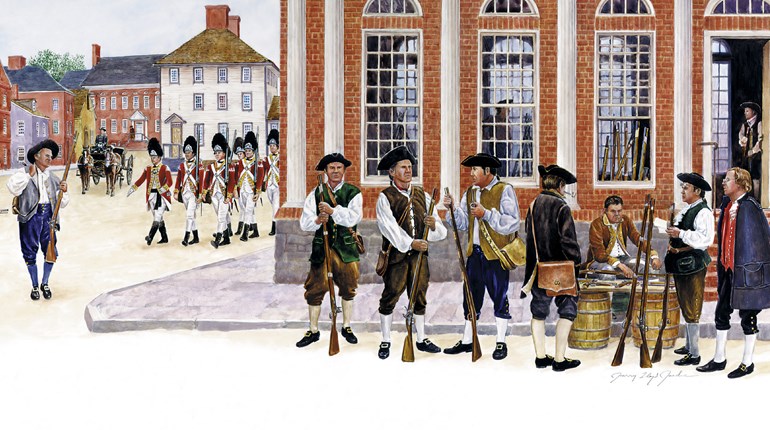
With the official arrival of summer just around the corner, we’re anxious to return to the great outdoors for a host of reasons. High on the list is keeping Carry Life skills up with consistent outdoor training. As much as we love the burgeoning of modern indoor facilities, they are still generally inhospitable to Job #1 in meaningful personal security—“getting off the ‘X.’” Indoor ranges allow for great practice of shooting skills, but safety demands that they proscribe many types of movement skills. So we gladly head outdoors.
Once we get to those long, hospitable days, the thoughtful practitioner also arrives at a warmer weather/warmer clime problem: If discreet carry is your goal—and we argue it always should be—how is discretion to be achieved? General warmth drives concealment and carry choices. Either you continue wearing the same sorts of cover garments, switch to lighter versions of same, or change to a different form of carry. We’d posit that all present non-trivial challenges. If your luck is bad enough, such garb may actually attract trouble, or at least unwelcome scrutiny.
We dismiss the first option as impractical on two lock-step grounds, though we leave it to you to decide which is worse. Garment types (if not the actual garments) that are workable in the other three seasons scream “I’m armed!” in the summer, and may largely undermine the point of discreet/concealed carry. If your luck is bad enough, such garb may actually attract trouble, or at least unwelcome scrutiny.
The second challenge here is raw discomfort: Overheat enough times in this sort of thermally unwise get-up, and you’ll stop carrying. We trust this needs no further explanation, but just in case: Your risks don’t go down as temperatures rise; in fact, there’s some statistical evidence that violent victimization goes up as the temperature does.
It’s no surprise, then, that cover garments trend lighter in higher temperatures. Several problems can come with this. Again, we leave severity for you to assess—while not subjective exactly, there are plenty of reasons that the issues aren’t consistent from person to person, or from region to region, and particularly not across all carry methods or positions.
The first is the amount, so to speak, of discretion made possible with garments constructed of lighter materials. The environment, in two senses of that word, authors the difficulties. A gust of wind may make your concealed carry unconcealed in a moment (either through actual exposure or printing). And, of course, the “snagging” potential for the covering garment jumps noticeably with similar unmasking result. Heavier materials naturally provide more proof against both.
Light weight can be a “double-whammy,” as we’ve observed before, especially if the need to draw occurs. In such an instance, even a soft wind or draft can cause a truly dangerous phenomena called “furling,” where the hand, gun, forearm or some combination of all three becomes fouled in the air-driven movement of the cover garment. Can you say “dropped gun”? We’ve seen it more than once or twice. … Even a soft wind or draft can cause a truly dangerous phenomena called “furling” …
Logically, the more thermally appropriate a garment is for summer wear, the higher the potential for furling. The lack of inertia in these garments makes them not stay put as cover, and not get the heck out of the way when access to the firearm is needed. As environmental air gets friskier and the firearm moves backward toward “kidney” carry, the likelihood and potential severity of this phenomenon increases.
This is how we get to a technique recommendation. Many of us were taught in our early carry days to detail the pinky finger to push back the garment as the palm, other fingers and thumb prepare to “find” the pistol, grip and draw. Some instructors now recommend a more decisive blading of all four fingers and a deeper “push” to clear that garment. We prefer the latter, mainly because it reduces the likelihood of a painful, terribly timed injury to that weak, exposed fourth finger, yet with practice imposes almost no other penalty. The bad news, however, is this makes only a trivial improvement in the propensity of light cover garments to furl.
Our suggestion on technique is therefore a bit of a theft. OK, it’s an outright theft, to which we add a modification. Those familiar with appendix carry will recognize both components. In appendix carry, the weak hand reaches aggressively across the torso to “lift” the cover garment, ideally clearing it up to as near the armpit as physique and garment construction allow. The master hand moves to the pistol, grips and draws. The hands join only after the muzzle points forward: Don’t get the weak hand out too soon, or you’ll be sweeping it in a very dangerous fashion.
You’ll have very little to modify if you already carry in appendix; it’s one of the decided strong suits of the method. One tip we find ourselves giving often, however, is the emphatic reminder to reach waaaaay over to the strong side before lifting the cover apparel at all. There are two benefits here: There’s almost no way to short-stroke your lift and foul on the butt of the pistol (you create the most clearance right where you need it without having to think about it as a separate step), and the construction of most cover garments limits upward travel almost perfectly by default. This assumes you have a garment of appropriate length to begin with, of course—it should not go much below where the pocket joins the outseam of the trousers or pants.
Hip or kidney carry folks, however, will need to adjust a good deal more. In these start positions, furling is the bigger worry and hazard, and so requires the most in terms of change. The weak hand portion of clearing follows the appendix model—reach well across, at least to the pocket of the strong side. The strong side hand follows this model, going not to the firearm, but wrapping around slightly behind it. For kidney carry, this will mean almost mid back.
There’s a temptation here to start the weak hand lifting first, as it generally arrives in position before the strong hand. Resist. Only when both hands are in position should the lift begin. Otherwise, you tension the bottom of the garment, and aggravate rather than alleviate the propensity to snag the butt of the firearm. If anything, go the other way—pull the grasp points slightly together to “luff” the garment out over the pistol. This isn’t technically essential, but helps with certain slightly larger, rubber-gripped, or more angular carry arms.
Now, pull as straight up as physique and cover garment material permit. The weak hand will encounter a natural stop with the elbow bent a little beyond 90 degrees, and this is the trigger for the strong hand to release and go for a grip of the pistol. Again, it’s important not to “sketch in” that strong hand action—if you do, you may wind up having to clear the butt of the gun from the last bit of cover garment, and this will slow you down. It also creates a sense of unnecessary urgency. The implicit “oops” you’ll feel may make you rush to the gun even more, risking a poor grip at the best, and a dropped gun at the worst. Finish that strong hand motion on the weak side cue. This isn’t technically essential, but helps with certain slightly larger, rubber-gripped, or more angular carry arms.
Lots of folks report that the release by the strong hand creates slack in the cover garment, and we agree, though it’s highly variable between shirt/garment types and fabrics. We prefer to see upward movement continue at this point, as the weak hand has nowhere to be just yet. Remember, you want to delay the join slightly anyway to avoid sweeping yourself. But if the initial lift is satisfactory—as near as you can get to the armpit with the weak hand—this is not a requirement.
A few details need to be cleaned up in our considerations. First, we’ve assumed a closed-front shirt, but note that no technique change is really required for an open-fronted (unbuttoned?) garment. The clearing and draw remain the same to prevent furling, but the unintentional unmasking issue is unchanged. We know folks who use a little discreet hook-and-loop (Velcro) to solve this. The garment is closed and remains so, but is “breakaway” in extremis. It’s a little more work, but a clever solution.
We touched on printing—a condition where the garment presses around the firearm to reveal its outline. This is a toughie, so to speak, and all but unavoidable. But because we’re big believers in not offending aesthetic distastes for carry—no matter how unreasonable such ignorance necessarily is—try lighter colors and patterns. Both extremes of color are more revealing we think, as well as solid colors, however slightly. At least patterns break up the shape visually—“politeness camo,” perhaps?
Finally, note that much of this motion can be staged. While it’s two-handed and thereby implies other sorts of compromise, it can be prepped—and de-escalated—without unmasking your defensive wherewithal. It is also not inherently aggressive to external observers, yet doesn’t impede any opportunity to withdraw, all while remaining maximally prepared. This last is always the best plan.
Now stay cool, enjoy the nice weather and Carry on.


































